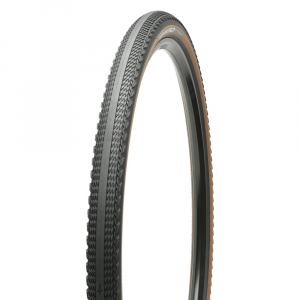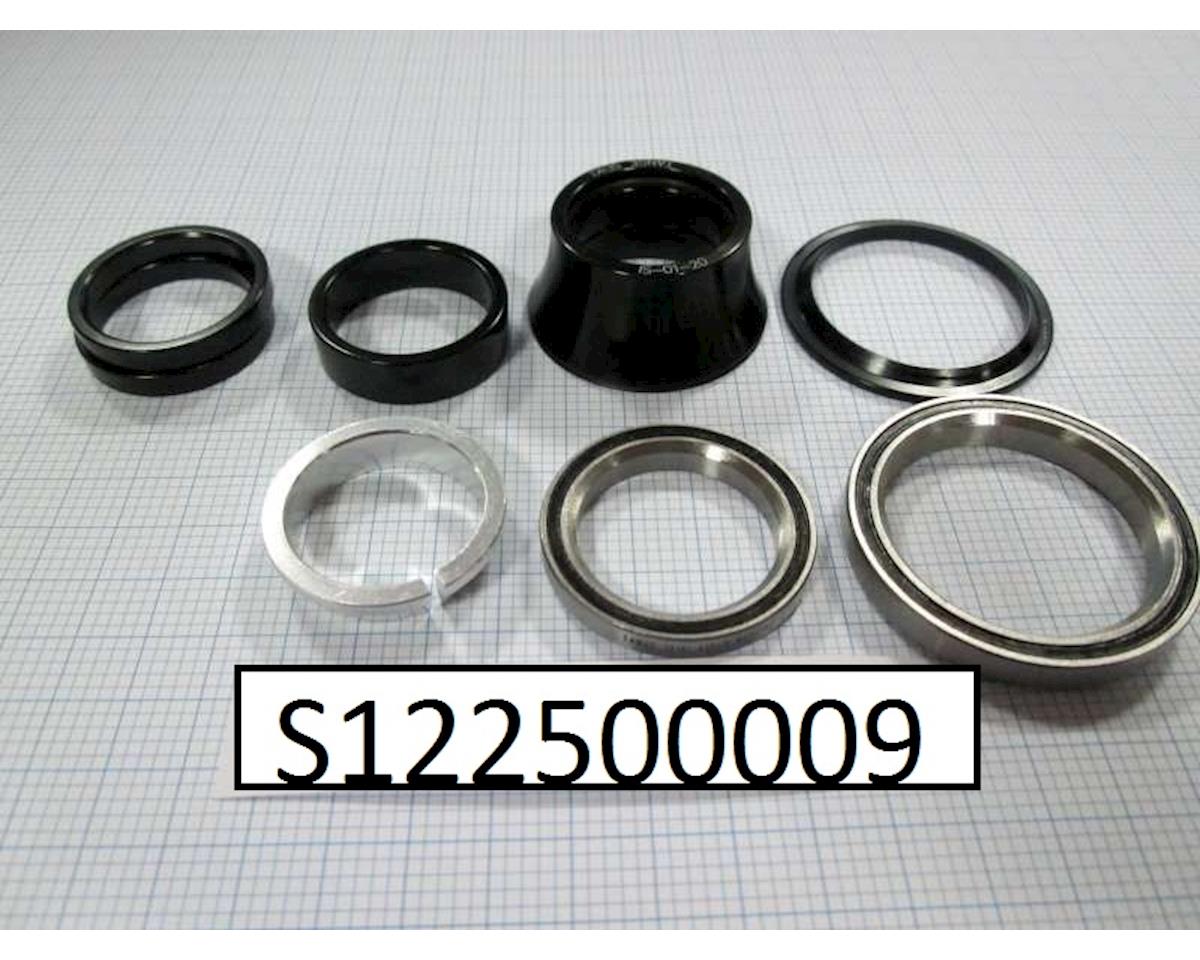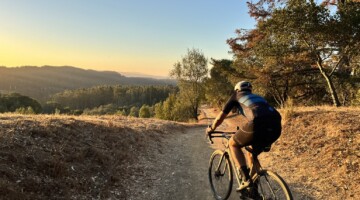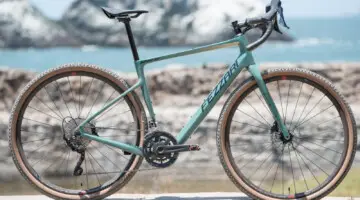Specialized first released its Diverge gravel bike with the Future Shock suspension system in 2017, and during that time, the design had already become a mainstay on the gravel scene.
Alison Tetrick, Olivia Dillon and Sarah Sturm are among the riders who have made names for themselves on the bike at the discipline's highest level, and the bike has proven a worthy option for many an amateur as well.
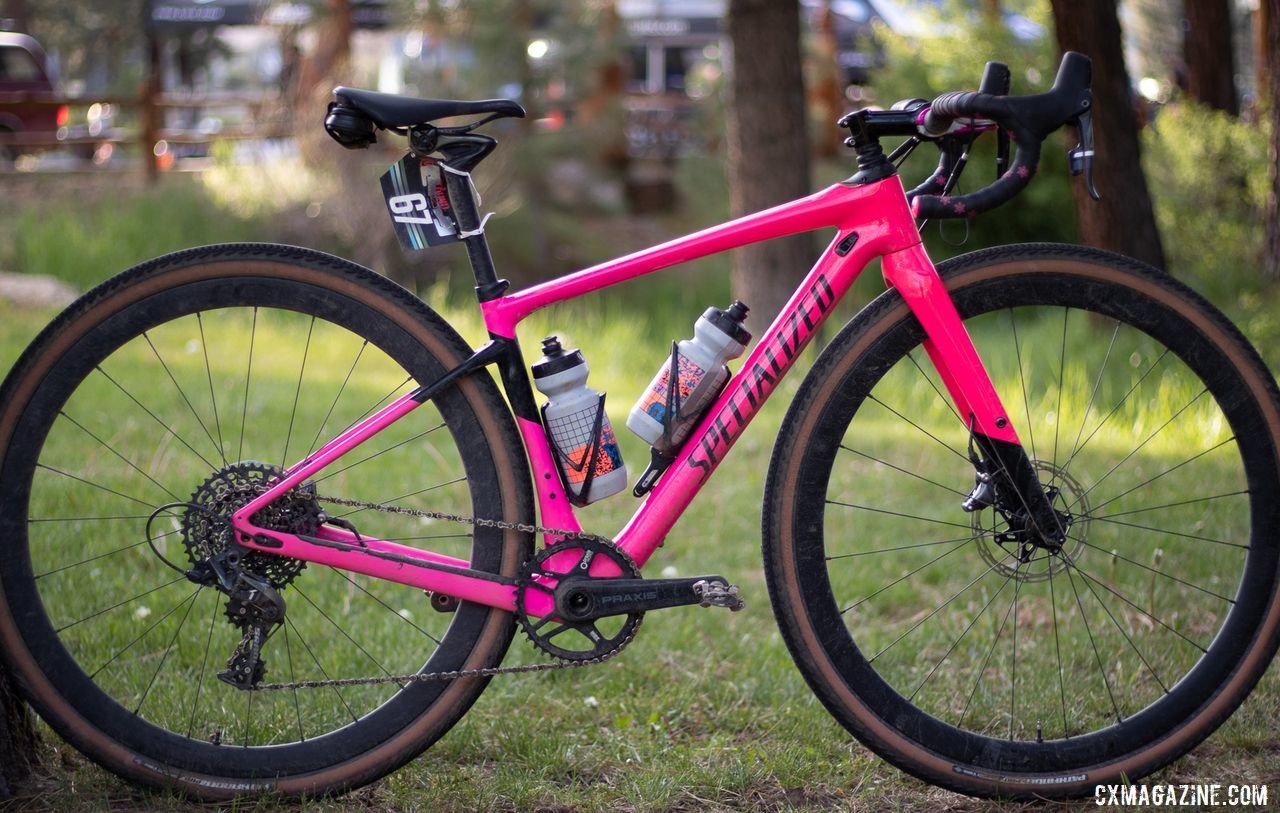
Sarah Sturm is among the riders on the Specialized Diverge gravel bike. Sarah Sturm's 2019 Lost and Found Specialized Diverge gravel bike. © A. Yee / Cyclocross Magazine
Notable about the Diverge when it was first released was the Future Shock front suspension system. The spring-based system replaced Specialized's old Zertz inserts by providing progressive compliance at the rider's hands. The Future Shock system returns to the Diverge for the 2020 model year along with the bike's FACT 9r carbon frame and Open Road Geometry.
We have done our share of gravel grinding on the 2020 Diverge Expert build for this long-term review. Find out if it is worth considering for your future gravel adventures.
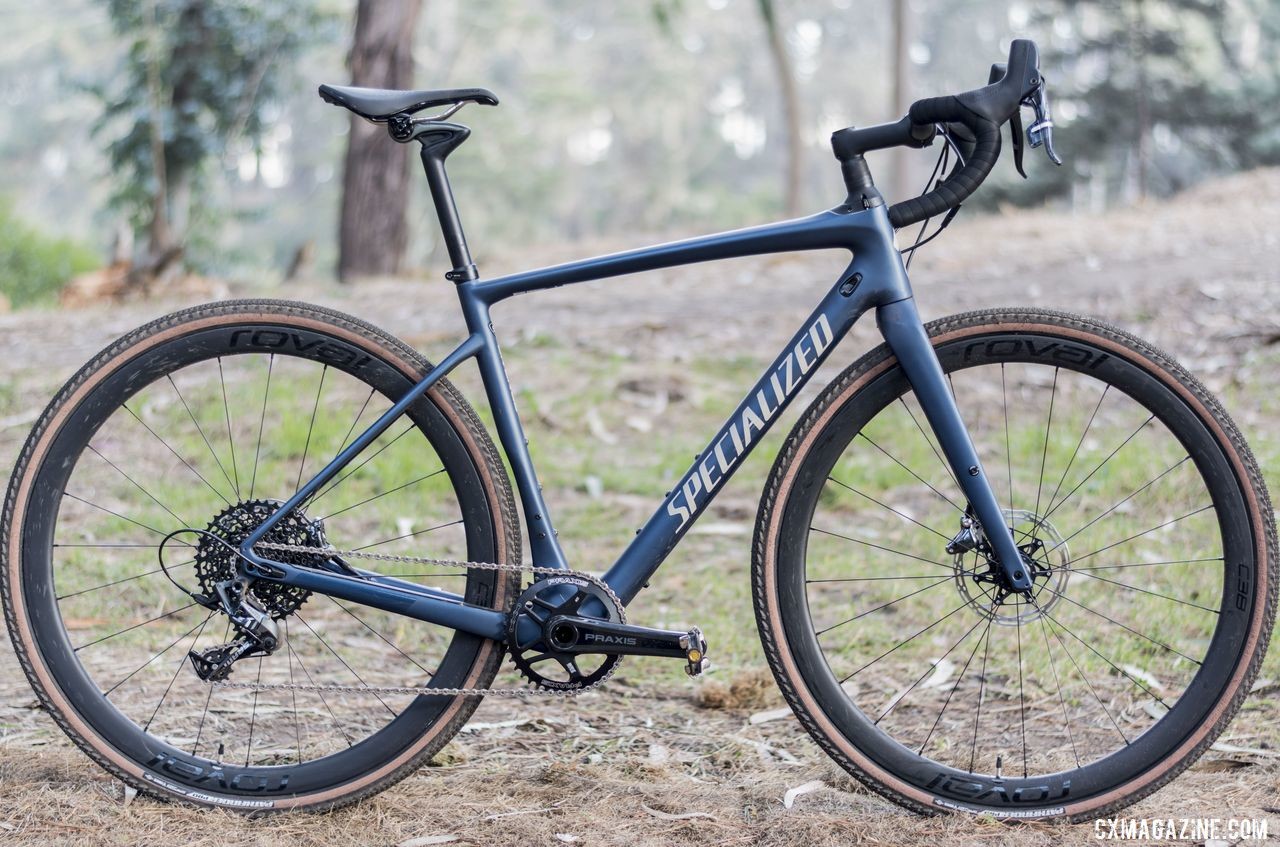
2020 Specialized Diverge Expert Gravel Bike. © C. Lee / Cyclocross Magazine
The Frame
The Specialized Diverge Expert has a Specialized FACT (Functional Advanced Carbon Technology) 9r carbon fiber frame. The numeric monikers refer to carbon fiber modulus and 9r is the lowest level on the Specialized scale now after the demise of 8r. The no-holds-barred Diverge S-Works is the only model that differs, offering the same frame with 11r carbon, the whole bike equipped with SRAM AXS for $10k.
Adding suspension to the front end of bikes is nothing new, with the practice starting with the Softride stem and Girvin Flexstem, followed by suspension forks, led by Rock Shox. One unique method of suspension was Cannondale’s Headshock located within the head tube of the frame.
With the renaissance of the 1980s mountain bike, aka the gravel bike of present times, we have seen a renaissance of these inventions with the RedShift Sports ShockStop stem, the suspension fork (Lauf, Fox AX, Cannondale Slate Lefty), the Trek IsoSpeed decoupler and now a head tube integrated shock, the Specialized Future Shock.
The Future Shock suspends the rider via a cartridge housed within the steerer tube with a progressive mainspring and a booster spring at the top to adjust firmness. The movement is above the upper headset race and moves linearly, so there is no change in the handlebar angle. The amount of movement is maximally 20mm.
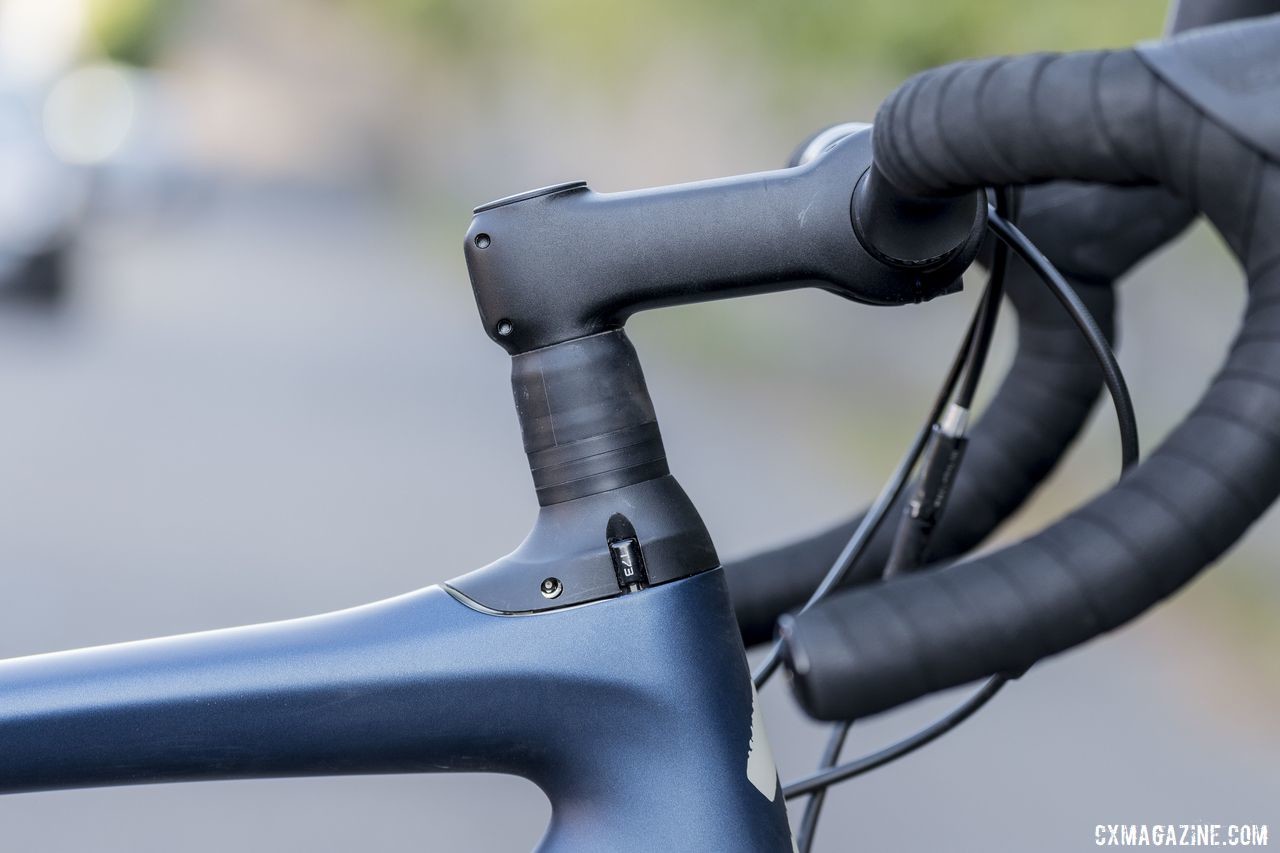
The Future Shock features a progressive spring system that provides compliance at the rider's hands. 2020 Specialized Diverge Expert Gravel Bike. © C. Lee / Cyclocross Magazine
When Specialized first released the Diverge, it said it wanted to move away from cyclocross geometry toward what it calls Open Road Geometry. After riding the bike, we would probably classify it as a "relaxed road" geo.
The head tube angle on the Diverge is a neutral 72.5 degrees on our 56cm review sample. The effective top tube length is 56.1cm. With a 60.4cm front center and 42.1cm chainstays, the wheelbase is 101.1cm.
It all sounds like a cyclocross bike until you notice the bottom bracket drop is an ultra-low 8.5cm. That’s 1.5 -2.5cm lower than most cyclocross bikes and 1.0-1.5 lower than most gravel bikes out there presently. Add big 700c rubber and you're back up a bit, but by all standards, it's low.
The reach for the Diverge 56cm is 379mm, and the 613mm stack height is a little on the high side and brings the handlebars up high.
There are three bottle mounting points, one under the down tube. The regular down tube and seat tube bottle mounts have three screws each for flexibility in placement or for a longer accessory cage.
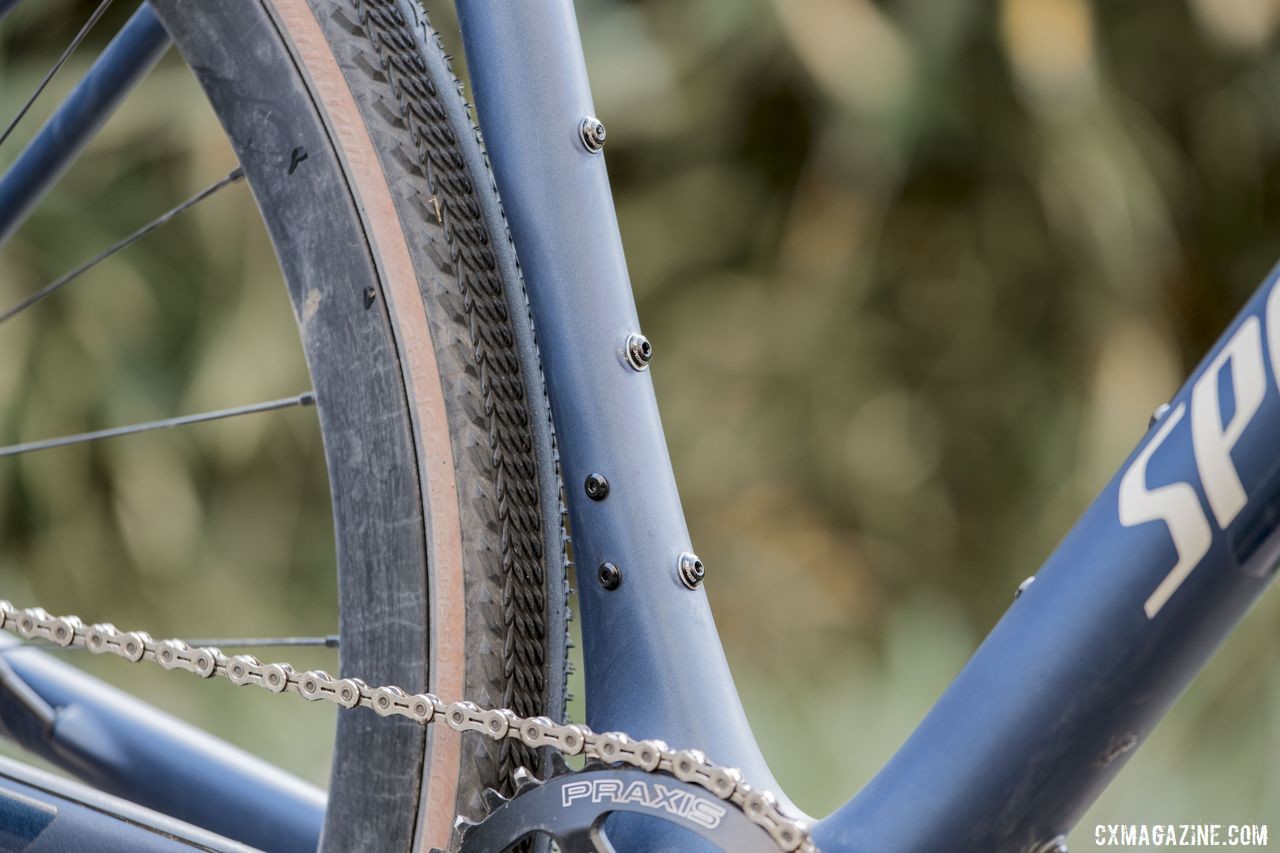
The seat tube features triple cage mounts for versatility. 2020 Specialized Diverge Expert Gravel Bike. © C. Lee / Cyclocross Magazine
There are also fender mounting provisions, though our Diverge Expert came with 700c x 38mm tires that make fenders a close fit.
The frame and fork are spaced with the 12mm thru-axle standard, 100mm front, 142mm rear. The control lines run internally entering the down tube, the derailleur lines with a cable stop so the cables are in the tubes without housing. There is a provision for a front derailleur cable, and a trap door below the bottom bracket shell to access the rear lines.
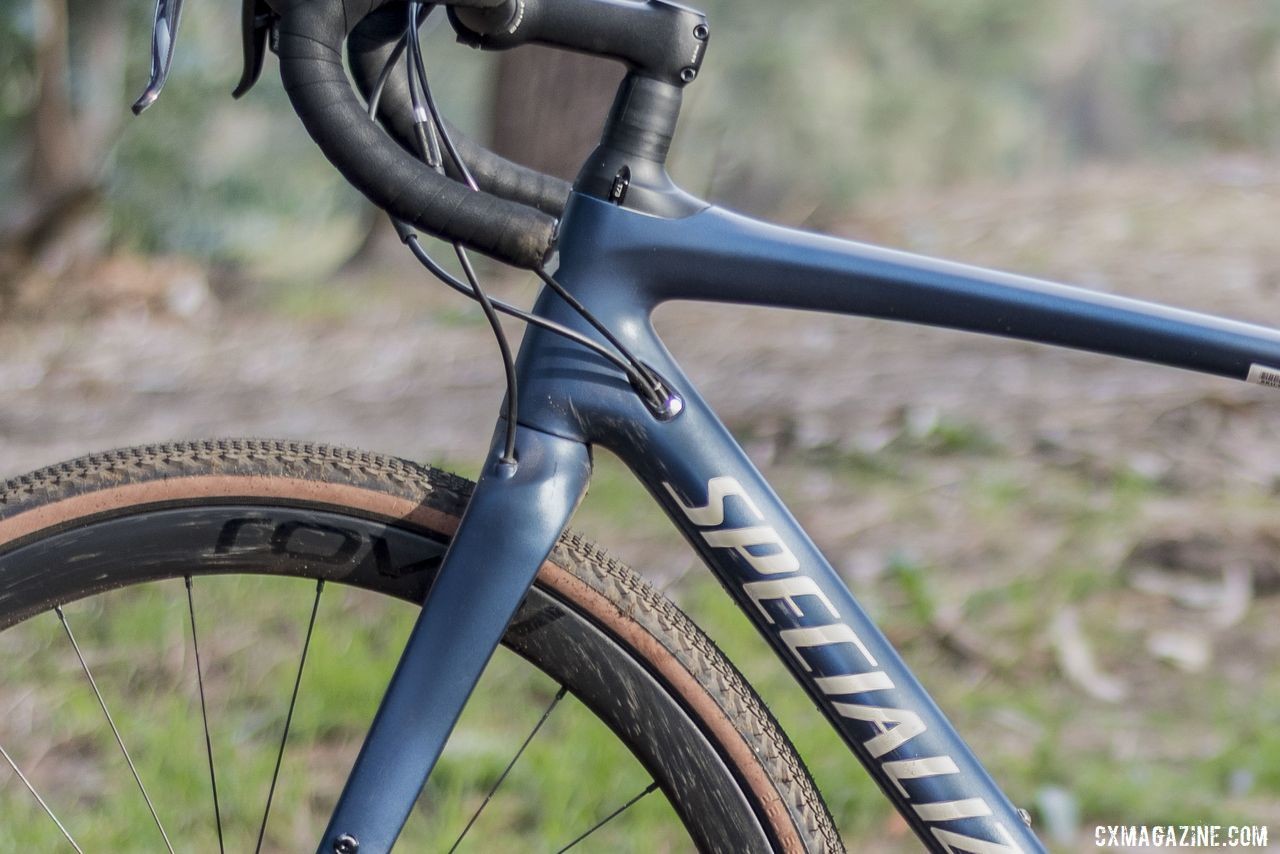
The Diverge has internal routing through the frame and fork. 2020 Specialized Diverge Expert Gravel Bike. © C. Lee / Cyclocross Magazine
The bottom bracket is a BB386. Specialized says the Diverge will fit 700c x 42mm tires or 650b x 47mm tires maximally, and we would attest that to be true.
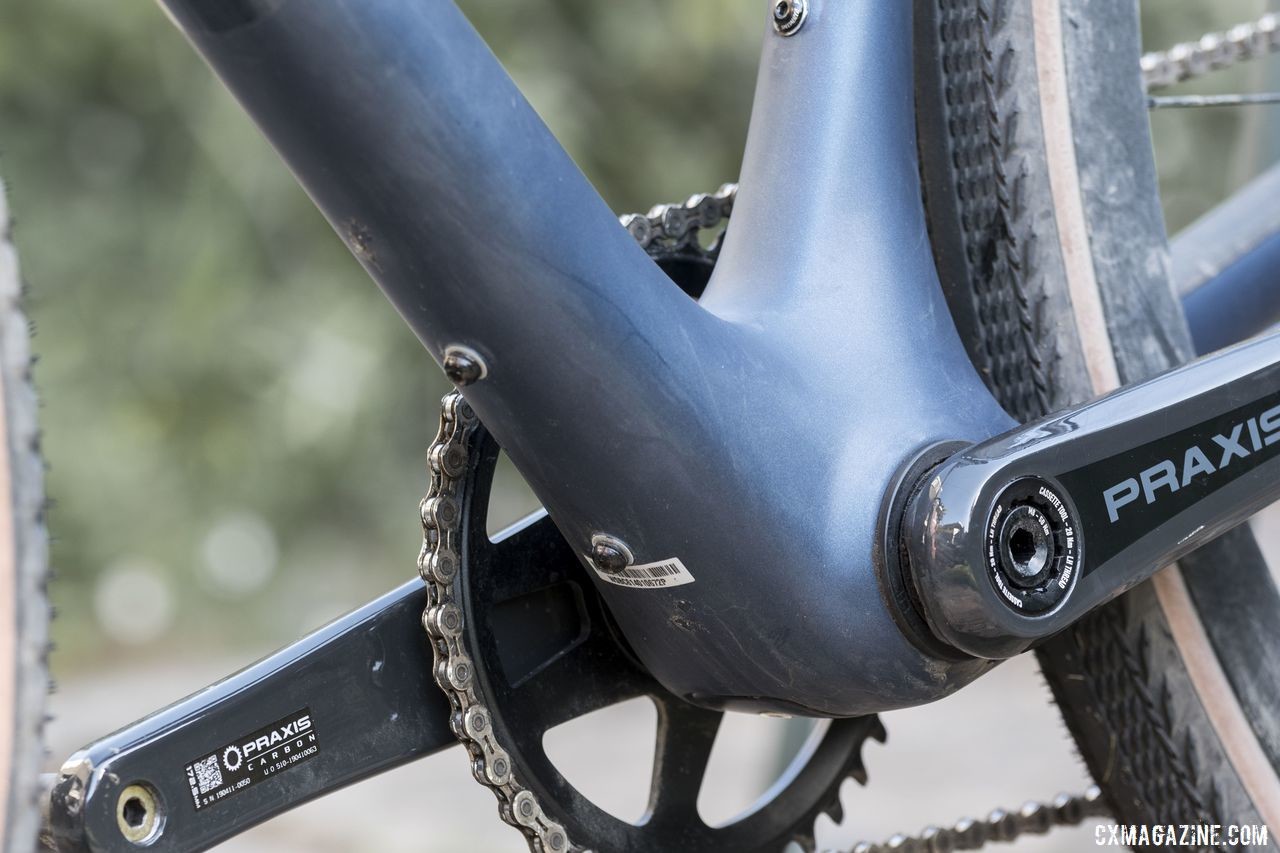
The Diverge has an extra cage mount under the down tube near the BB386 EVO bottom bracket. 2020 Specialized Diverge Expert Gravel Bike. © C. Lee / Cyclocross Magazine
The full carbon fork has a tapered steerer with a flat mount for the brake caliper with an internally run brake line and mounting screws on the blades for a front rack. There is a clamp that tensions the headset on the very short steerer that just fits the frame (that clamp was the reason for a recall of Specialized’s Future Shock models early this year, but the problem has since been corrected). The Future Shock slides into the steerer and is held in place by a set screw. The stem mounts to the Future Shock directly.
The whole package is painted a very attractive though understated metallic blue.
The Build
All the Specialized Diverge models—except for the E5 alloy and S-Works carbon—use the same FACT 9r carbon frame and differ by build. We reviewed the Expert build, which is below the S-Works and Pro models, but above the Sport model.
Specialized spec'd the 1x drivetrain around the SRAM Force 1 groupset. Specialized modified the drivetrain with the addition of a Praxis Zyante Carbon 1x crankset with a 40-tooth Wave Tech chain ring. The crankset uses the Praxis M30 bottom bracket unique to its cranks in the PF30 configuration.
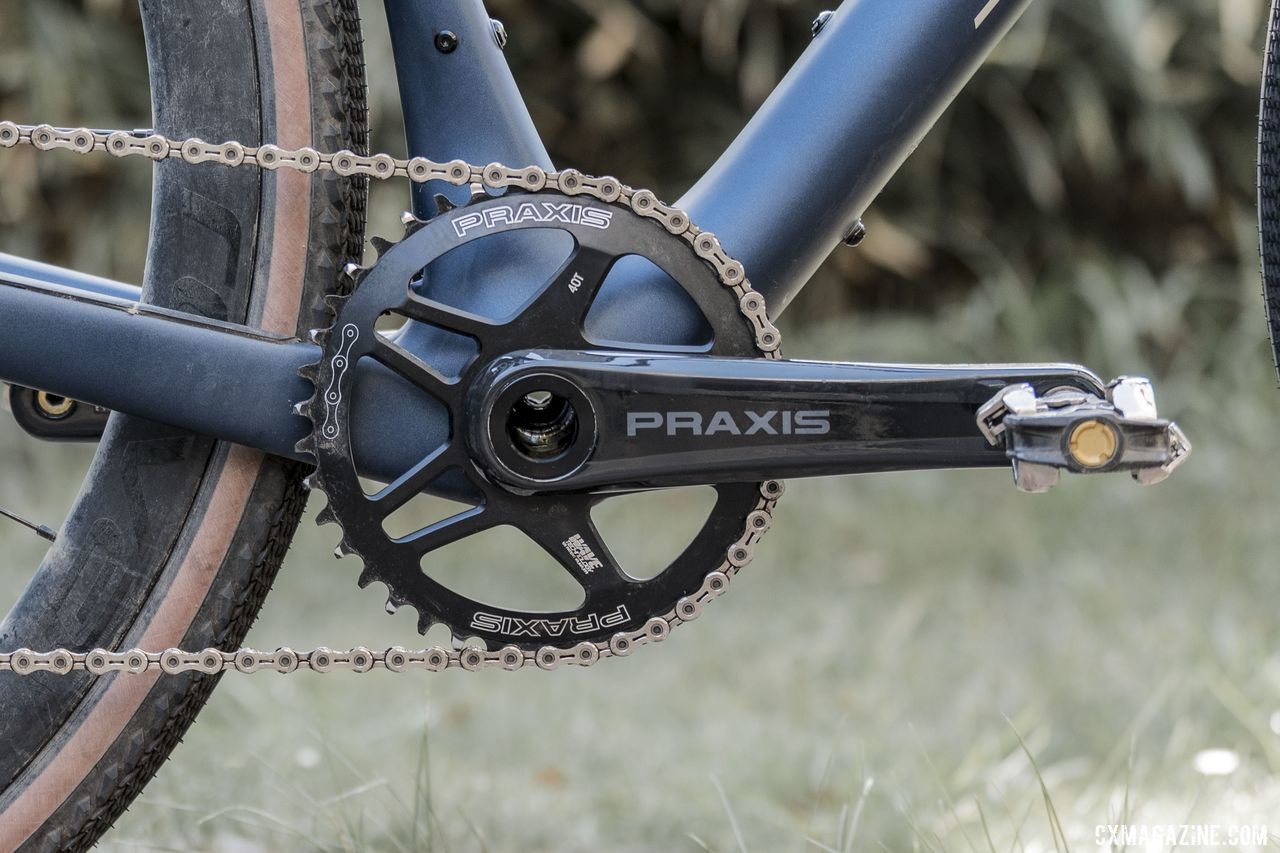
The 1x drivetrain features a Praxis Zayante Carbon 1x crankset and 40t Praxis Wave Tech chain ring. 2020 Specialized Diverge Expert Gravel Bike. © C. Lee / Cyclocross Magazine
The rear derailleur is a SRAM Force 1 model, and the KMC X11 EL chain shifts across a 10-42t SRAM XG-1150 cassette mounted on an XD driver.
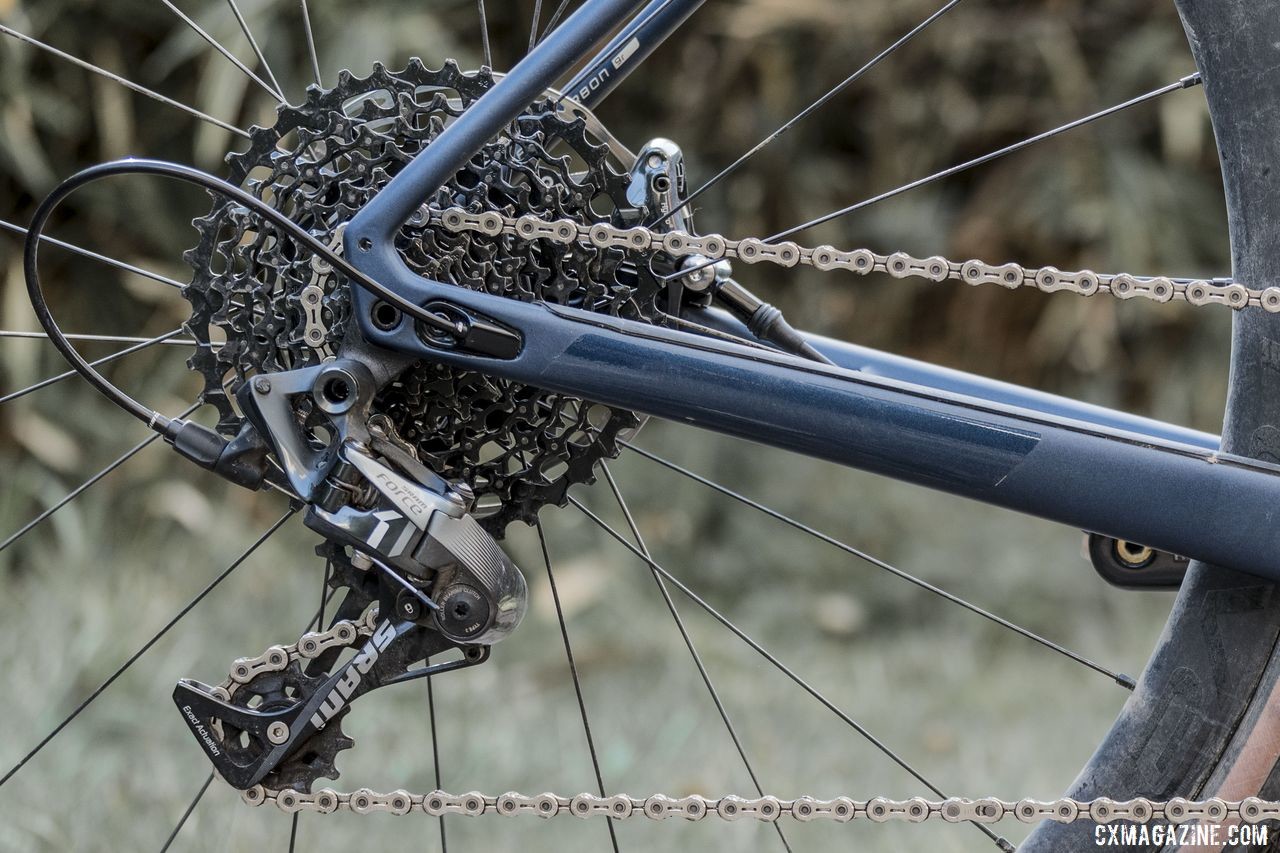
The 1x drivetrain features a SRAM Force 1 rear derailleur and a spinny 10-42t cassette spread. 2020 Specialized Diverge Expert Gravel Bike. © C. Lee / Cyclocross Magazine
Although the Expert build is not at the top of the line, Specialized specs the bike with Roval C38 carbon tubeless clinchers. The 1,560g (claimed) 700c wheels have 38mm-deep rims that have 21mm and 26.5 external widths. Twenty-four DT Swiss Competition (2.0/1.8/2.0) j-bend spokes lace the rims to the DT Swiss 350 disc hub. The front has radial spokes on the non-rotor side, otherwise, the wheels are laced 2x.
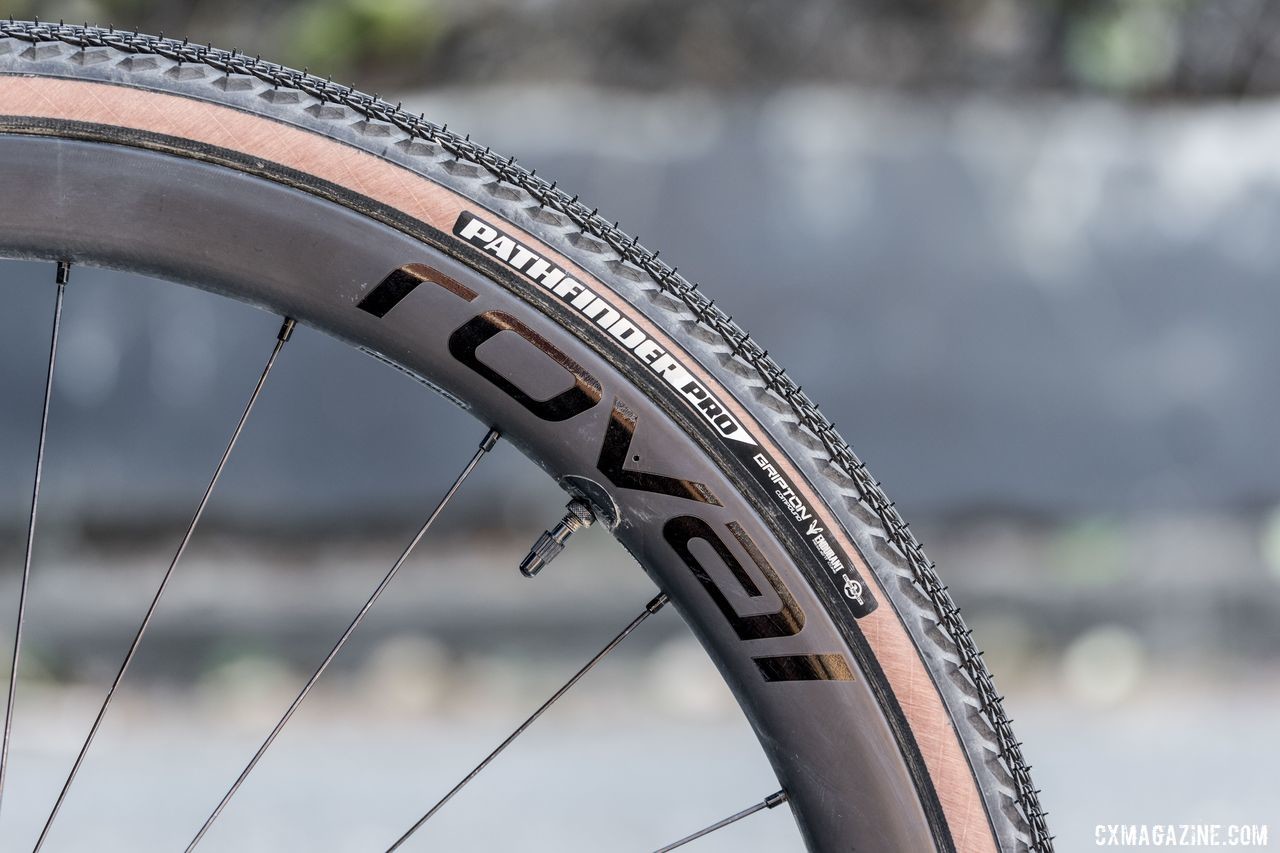
The Expert Diverge comes stock with Specialized Pathfinder Pro 38mm tires on Specialized Roval C38 carbon disc wheels. 2020 Specialized Diverge Expert Gravel Bike. © C. Lee / Cyclocross Magazine
The Specialized Pathfinder Pro 700c x 38mm 2Bliss tires shipped with tubes installed, but the set also comes with tubeless valves. We immediately and easily set the wheels up tubeless.
The cockpit has a Specialized Adventure Gear Hover aluminum bar that rises above the stem by a centimeter and flares 12 degrees toward the drops. The width is 42cm c-c at the brake hoods. The bars are clamped by a 100mm aluminum stem.
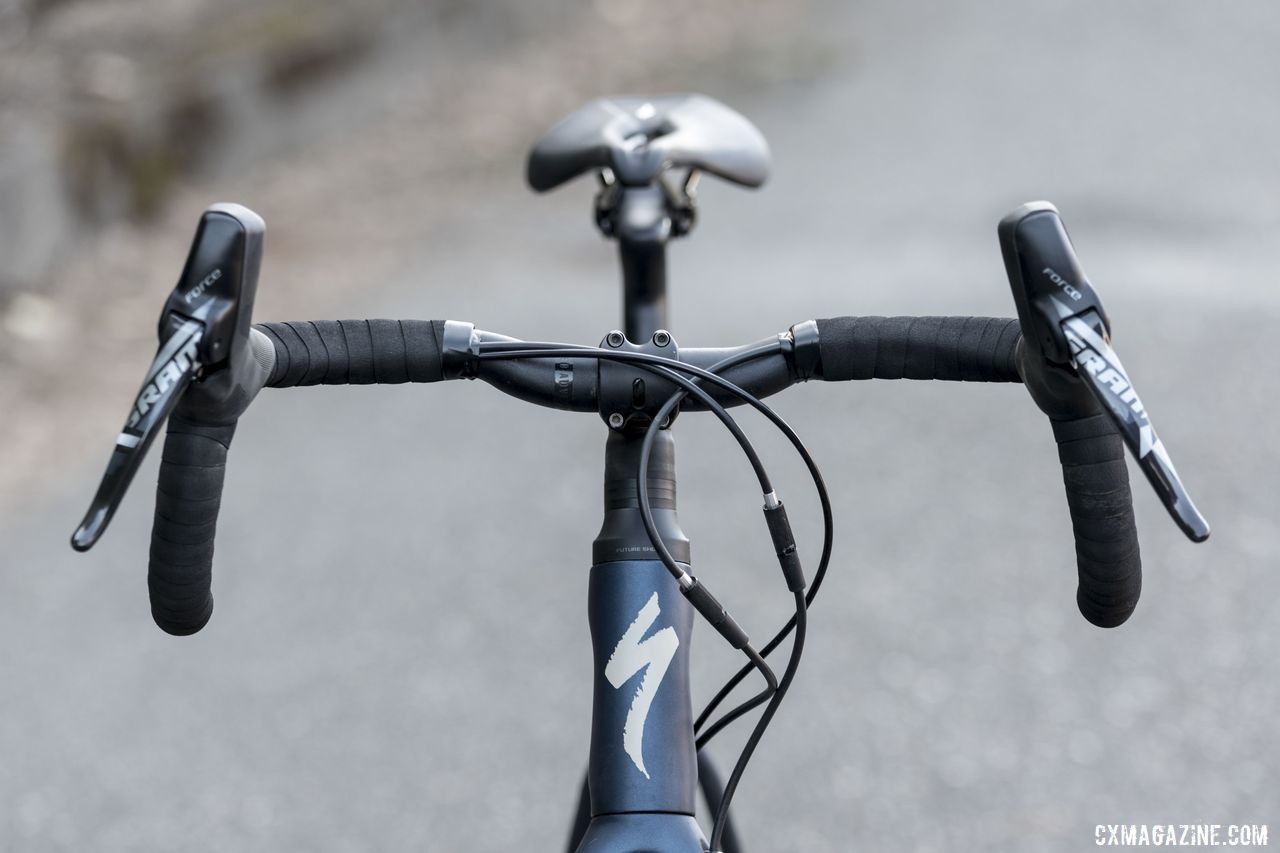
The stock cockpit features a Specialized Adventure Gear Hover bar and Future alloy stem. 2020 Specialized Diverge Expert Gravel Bike. © C. Lee / Cyclocross Magazine
The seatpost is a 27.2mm carbon CG-R Specialized model, sometimes nicknamed the “Cobble-Gobbler” from its early days, which has a bend with an elastomer (Specialized Zertz) insert as a shock absorber and damper. The single-bolt clamp on the post is topped with a Specialized Body Geometry Power Expert with hollow titanium rails.
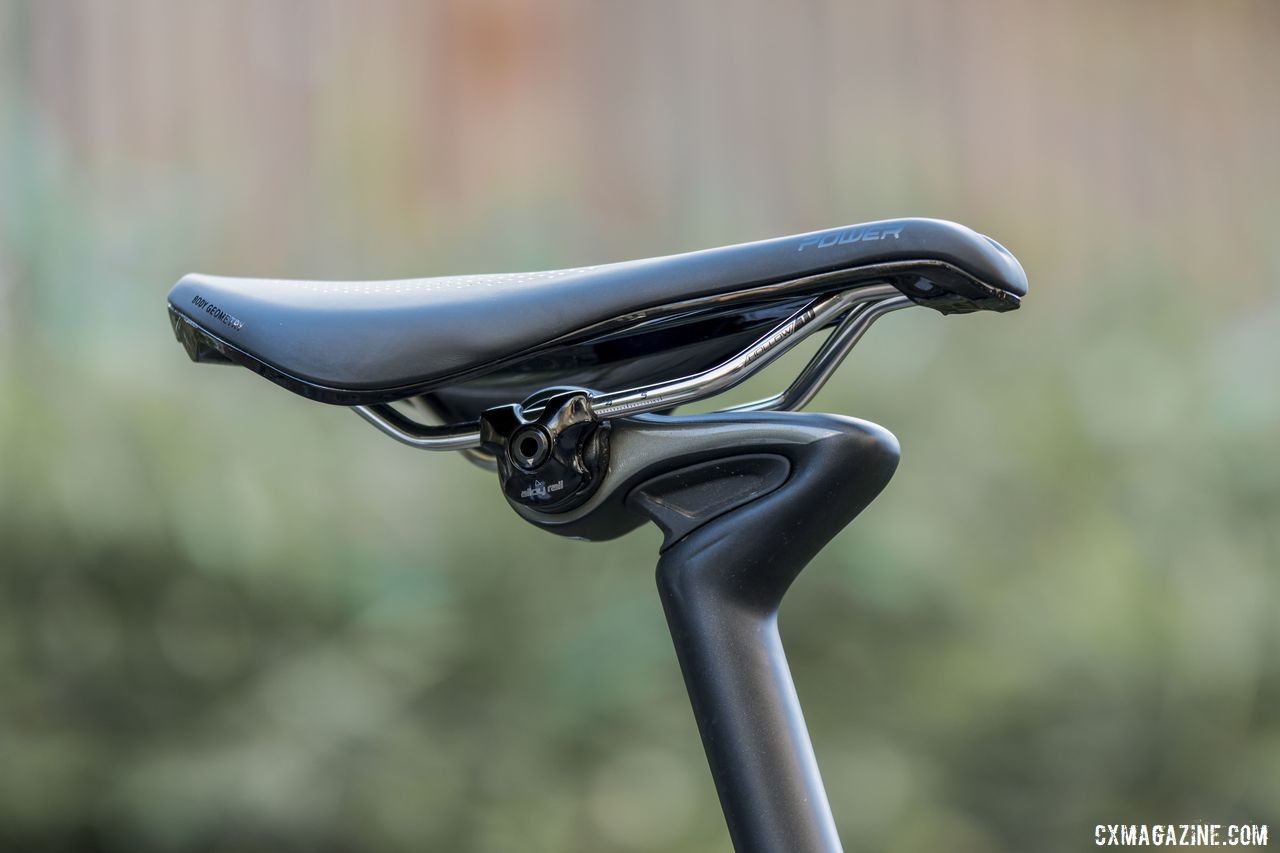
Specialized CG-R carbon single bolt seatpost. Body Geometry Power Expert saddle with Ti rails. 2020 Specialized Diverge Expert Gravel Bike. © C. Lee / Cyclocross Magazine
The full setup weighs 19.0 pounds without pedals and 12.0 pounds without wheels.
The MSRP for the Diverge Expert is $4,750.
The Ride
The low-slung Specialized Diverge Expert has seen a lot of action since we received it. You immediately notice a remarkable smoothness thanks to the Future Shock, which is quite active as long as your hands are on the bars.
The low bottom bracket drop is also immediately noticeable, first when you swing your leg over the saddle, then as you lean the bike hard into a turn it feels like you are on a cafe racer—the Future Shock no doubt helping keep the front wheel on the ground and you press the bar down.
For my 155 pounds of rider weight, I used the installed stiffest spring in the Future Shock. There was about 5mm of visible sag in the front when sitting on the bike with my hands on the hoods. It sags a bit more as you lean forward to reach down to the drops, but barely.
Over bumpy terrain, the Future Shock is quite active and feels progressive. I never bottomed out, even coming down a few stairs or on small drops. Since the movement is vertically in line with the steering axis, there was no change to the bike geometry—the front end merely moves up towards you as your bar stays in place over a bump less than 20mm.
At least that’s the theory, though in reality your hands and arms will still feel the bumps, but they are muted. The Future Shock has some damping, and it never felt like the rebound amplified any of the bumpiness.
The Diverge has certainly more road-oriented geometry than some of the new gravel bikes such as the Kona Libre DL we recently reviewed.
Compared to Specialized’s own Roubaix, the Diverge is a more relaxed road bike even with its 59mm trail (compared to the Roubaix’s 55mm trail calculation). Your position will be a bit more upright, and with the longer wheelbase and lower bottom bracket, the ride will be more stable in comparison. Just for comparison, an average cyclocross bike has around 65mm of trail and a standard road bike is around 55-59mm.
Enough with calculations and suspected effects on handling. The Diverge indeed handles like a road bike, carving through turns with just a lean, never wavering from your chosen line. With both the 38mm tubeless tires and the Future Shock, every road seems as if it’s newly paved, or at least one level of pavement better than it actually is.
The smoothness creates confidence with the road bike handling on poor road surfaces and especially in corners on those bad roads. I did not feel the CG-R seatpost contributed anything, and I swapped it for a rigid post just to see if I could notice any difference over the same conditions. It was not a blind test, but I could at least say I could not confidently say there was a noticeable difference.
Once off pavement, the bike felt worthy of our test tracks including fire roads with small buried rocks and some surface looseness, loamy trails punctuated with roots and singletrack trails of varying surfaces including some rocks and twisting tightly through trees. We pushed the Diverge hard on a couple of cyclocross courses and it was a reasonable contender.
The advantage of the Future Shock acted almost as a damper to the fast-handling front end. Going down some steep, rocky sections, it felt as if I might go over the bar, but the mild shock absorption from the Future Shock helped me regain composure and control.
The low bottom bracket came as both a merit and demerit—the low position kept the center of gravity low, but also produced more pedal strikes. Not every system is perfect, of course. In the tight tracks through the trees and chicanes, the minor bar movement from the Future Shock made precise steering a bit more challenging.
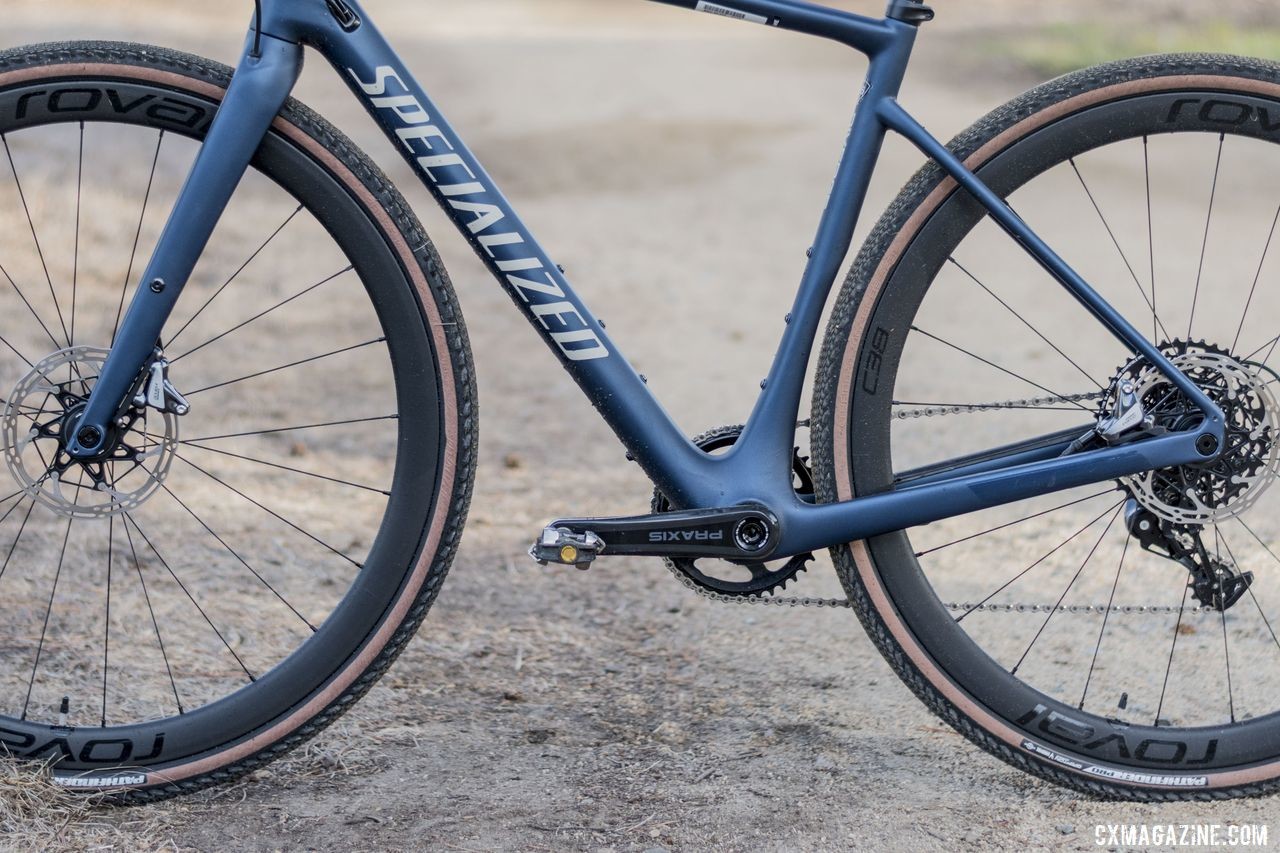
The Diverge has a very low bottom bracket, with a BB drop of 8.5cm. 2020 Specialized Diverge Expert Gravel Bike. © C. Lee / Cyclocross Magazine
The Specialized Hover bar follows the trend of adding rise by bending the top of the handlebars up at the stem. I suppose this is a way to gain a higher position without a rise to the stem and there is a negligible aesthetic or even aerodynamic advantage. While I don’t love the look, the Diverge requires a tall stack above the headset to fit the Future Shock, so I think having a riser stem would look worse.
We are all familiar now with the SRAM Force 1 components, and though I thought the substitution of the Praxis crank is nice to give the small company some love, the SRAM Force bottom bracket is more universal and I dislike the fixed bearing of the Praxis M30 bottom bracket conceptually since it puts more strain on one side, potentially leading to premature wear.
Roval is a Specialized house brand (albeit one that's now seeking its own time in the sun and gravel) and the included Roval C38 wheels get the job done. I’m glad they have proven DT Swiss hubs with normal J-bend spokes with external nipples. The Specialized Pathfinder tires are a good choice for this bike, but I’d prefer the Tracer Pro 2Bliss as a stock tire since my mixed-terrain riding veers mostly off the pavement.
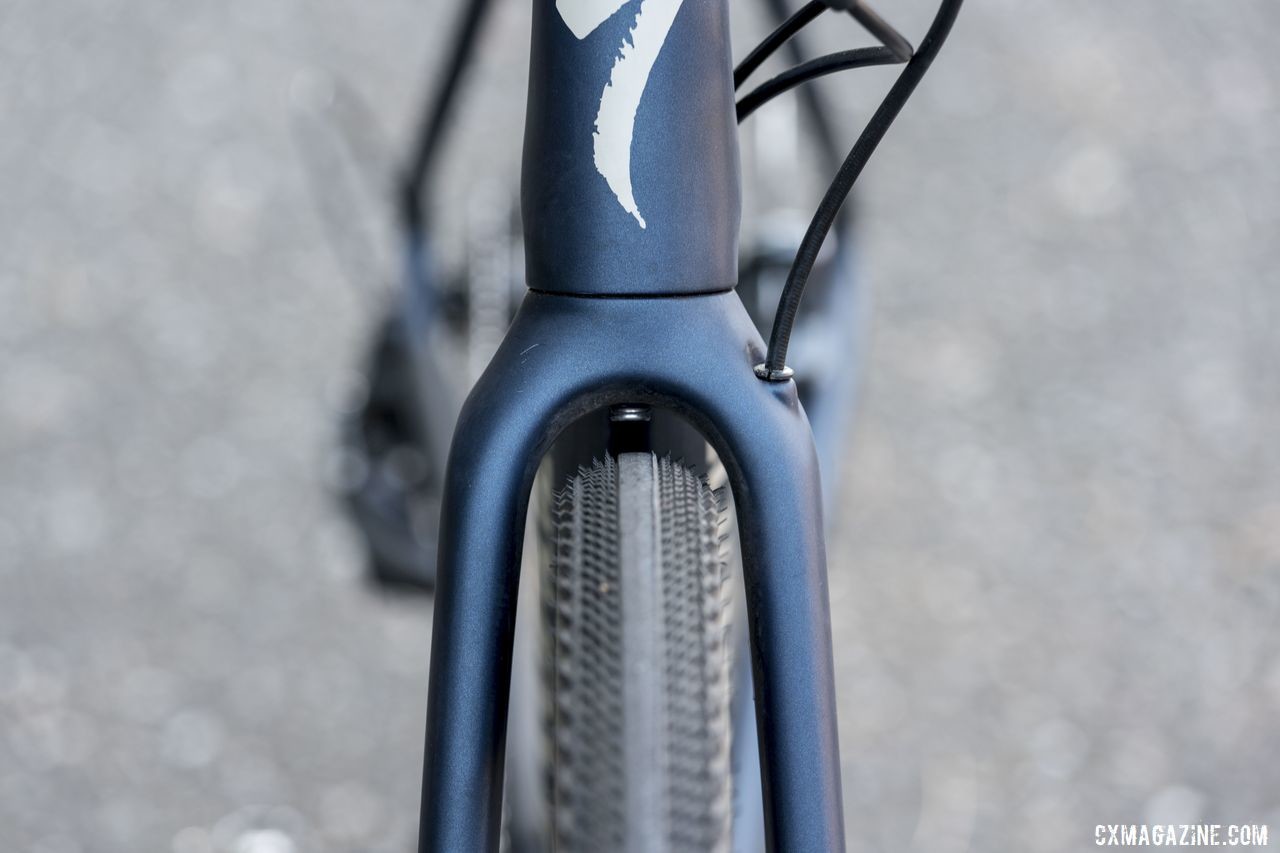
The Diverge Expert comes with 700c x 38mm Pathfinder Pro tires. Specialized claims clearance for tires up to 700c x 42mm and 650b x 47mm wide. 2020 Specialized Diverge Expert Gravel Bike. © C. Lee / Cyclocross Magazine
One odd occurrence we encountered is related to the rear derailleur hanger that has the axle shelf as part of its design. It is held on with a single screw. When reinstalling a wheel, the hanger was inadvertently rotated just so the thru-axle did not align to thread in, which was frustrating although the fix was easy. Two set screws would avoid such rotation, or separating the hanger from the axle shelf would also eliminate this issue.
The Verdict
The Specialized Diverge Expert is a fun bike to ride and truly embodies the all-road design. The traditional road geometry with ample tire clearance and the addition of an active suspension system makes for an ideal machine for spirited mixed-terrain riding.
The smoothing effect of the Future Shock and the stability of the low bottom bracket render the bike suitable for long days in the saddle. The design of the Future Shock seems simple enough to be reliable and the headset is easy enough to adjust once you know the technique. All who tried the Diverge seemed skeptical at first but grew to quickly appreciate and like the bike. It has become my bike of choice for long days in the saddle on bumpy gravel roads, before its inevitable return.
For more on the 2020 Specialized Diverge Expert, see the specs and photo gallery below.
2020 Specialized Diverge Expert Specs
MSRP: $4,750 USD
Weight: 19.0 pounds, no pedals; 12.0 lbs, without wheels or pedals
Frame: Specialized FACT 9r carbon fiber monocoque, 12mm thru-axle, flat mount disc
Fork: Specialized FACT 9r carbon fiber, Future Shock, 12mm thru-axle, flat mount disc
Shifters: SRAM Force 1 hydraulic 11 speed
Brakes: SRAM Force 1 hydraulic, Avid rotors 160mm front, 160mm rear
Crankset: Praxis Zayante Carbon 1x
Chain Ring: Praxis Wave Tech, 40t
Rear Derailleur: SRAM Force 1
Cassette: SRAM 1150 10-42t
Wheels: Roval C38 carbon tubeless clinchers, 21mm internal width
Tires: Specialized Pathway 700c x 38mm 2Bliss clinchers
Cockpit: Specialized Future 100mm stem, 42cm Hover aluminum bar
Seatpost: CG-R carbon 27.2mm diameter
Saddle: Specialized Body Geometry Power Expert
Warranty: Lifetime, frame and fork, wheels against defects in manufacturing
Country of origin: Taiwan
More Info: specialized.com














